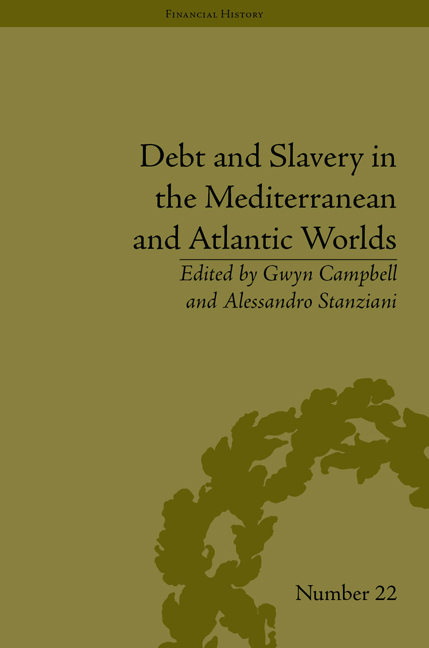Book contents
- Frontmatter
- Contents
- Acknowledgements
- List of Contributors
- Introduction
- 1 Debt Bondage and Chattel Slavery in Early Rome
- 2 Slavery, Debt and Bondage: The Mediterranean and the Eurasia Connection from the Fifteenth to the Eighteenth Century
- 3 Clientship, Social Indebtedness and State-Controlled Emancipation of Africans in the Late Ottoman Empire
- 4 Pawnship and Seizure for Debt in the Process of Enslavement in West Africa
- 5 The Business of ‘Trust’ and the Enslavement of Yoruba Women and Children for Debt
- 6 The Africanization of the Workforce in English America
- 7 Credit, Captives, Collateral and Currencies: Debt, Slavery and the Financing of the Atlantic World
- 8 Unpayable Debts: Reinventing Bonded Labour through Legal Freedom in Nineteenth-Century Brazil
- 9 Indigenous Debt and the Spirit of Colonial Capitalism: Debt, Taxes and the Cash-Crop Economy in the Anglo-Egyptian Sudan, 1898–1956
- Notes
- Index
Introduction
- Frontmatter
- Contents
- Acknowledgements
- List of Contributors
- Introduction
- 1 Debt Bondage and Chattel Slavery in Early Rome
- 2 Slavery, Debt and Bondage: The Mediterranean and the Eurasia Connection from the Fifteenth to the Eighteenth Century
- 3 Clientship, Social Indebtedness and State-Controlled Emancipation of Africans in the Late Ottoman Empire
- 4 Pawnship and Seizure for Debt in the Process of Enslavement in West Africa
- 5 The Business of ‘Trust’ and the Enslavement of Yoruba Women and Children for Debt
- 6 The Africanization of the Workforce in English America
- 7 Credit, Captives, Collateral and Currencies: Debt, Slavery and the Financing of the Atlantic World
- 8 Unpayable Debts: Reinventing Bonded Labour through Legal Freedom in Nineteenth-Century Brazil
- 9 Indigenous Debt and the Spirit of Colonial Capitalism: Debt, Taxes and the Cash-Crop Economy in the Anglo-Egyptian Sudan, 1898–1956
- Notes
- Index
Summary
Comparative versus Global History of Debt Slavery
Bondage in ancient Rome and Northern America has often been presented as forms of chattel or ‘real’ slavery as opposed to the ‘mild’ or hybrid forms of slavery, servitude and coercion found in so many different contexts in Africa, Asia and medieval Europe. Such a distinction is problematic. Anthropologists, sociologists and historians differ considerably in their assessments of what precisely constitutes slavery, highlighting variously issues of social status (membership of or exclusion from the clan, family and local community), religion, legal status (forms of dependence, freedom of movement, hereditary nature of constraints), economic conditions and political, legal and procedural rights. Researchers have pinpointed several variables in their attempts to find a definition of bondage, but without reaching a consensus.
The debate has sharpened even more over the last two decades as cultural and subaltern studies scholars have highlighted the relativity of notions of freedom and coercion. As a result, the critical question currently asked is whether the different forms of servitude found in various societies in Africa, Asia, the Indian Ocean world or the Americas can all be considered to constitute ‘slavery’. If the answer is yes, then by implication slavery existed before and independently of colonialism. Conversely, if the answer is no, it means that these were forms of ‘imperialist’ dependence and bondage specific to a particular place.
- Type
- Chapter
- Information
- Publisher: Pickering & ChattoFirst published in: 2014

